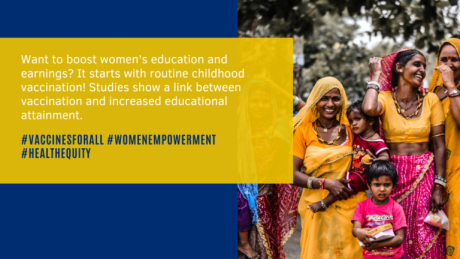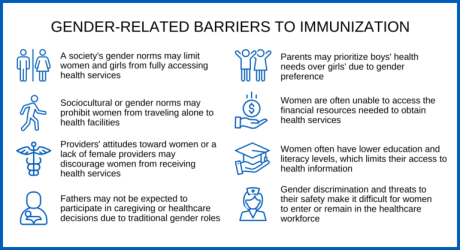Breaking the Barriers: How Gender Equity Advances Immunization
Gender roles and norms can profoundly impact immunization uptake and health outcomes for women, children, families, and communities. In order to support immunization coverage and reach zero-dose children, it is essential to understand and address how gender can influence the access and delivery of vaccines.
In recognition of International Women’s Day on March 8, IVAC is spotlighting several projects that support the critical relationship between immunization and gender equity for women and girls.
Gender Equity Advances Immunization: An Evidence Synthesis

Studies show a link between vaccination and increased educational attainment.
Gender equity contributes to immunization coverage, and vice versa: Research from across public health disciplines has shown that empowering women increases the chance that mothers will immunize their children. In turn, childhood vaccination can reduce gender disparities by preventing illness, thereby promoting higher educational attainment and labor participation for women. Immunization has been highlighted as a catalyst for advancing gender equality by addressing gender-related barriers to health care. IVAC’s Value of Immunization Compendium of Evidence (VoICE) project recently compiled the latest research on the connection between gender equity and immunization.
Learn more on VoICE.
The Immunization Economics of Equitable Education
IVAC health economists working on the Vaccine Economics Research for Sustainability and Equity (VERSE) Toolkit have found that maternal education is a dominant contributor to vaccine inequity, accounting for up to 56% of the variation in vaccine coverage in LMICs. This finding underscores the importance of increasing access to education for girls, which will contribute to higher immunization coverage, lower morbidity and mortality, and other long-term health impacts.
Read the study to learn more.
Improving Gender Equity to Reduce Zero-dose Prevalence

A list of gender-related barriers to immunization.
Improving gender equity is one pathway to increase immunization coverage, especially among zero-dose children. IVAC was commissioned by Gavi, the Vaccine Alliance to explore gender-related barriers to reaching zero-dose children. The Knowledge Summary synthesizes the latest peer-reviewed evidence on the role of gender in addressing zero-dose and immunization equity, while the Advocacy Brief provides an overview of how gender equity influences immunization, as well as some recommendations for advocates and policymakers to promote gender equity for all.
Improving the Lives of Women and Children in India: Dividends for Maternal and Child Health
The Johns Hopkins Maternal and Child Health Center in India was founded in early 2020. Part of its mission focuses on reducing disparities and improving the lives of mothers and children in India. “We often keep the child at the center of our activities,” said MCHI Director and IVAC’s Director of Child Health Anita Shet, MD, PhD. “However, keeping the spotlight on women and ensuring equal rights can have longer dividends in maternal and child health. An equity approach to immunization and child health is not only a moral imperative but also results in the best use of our resources.” One of MCHI’s initiatives is the Maternal and Child Health Utilization and Equity Study (MATCHES), which aims to understand the impact of the COVID-19 pandemic on the utilization of healthcare among women and children in India, which can exacerbate gender inequities in these vulnerable groups.
Increasing Demand for Maternal Immunization
In partnership with Jhpiego, IVAC works on the Maternal Immunization Readiness Initiative (MIRI) to conduct implementation and communication research to inform the future delivery of new vaccines during pregnancy in Kenya and Bangladesh. IVAC’s team is conducting qualitative research to determine knowledge, attitudes, and behaviors shaping vaccine decision-making for pregnant and lactating women, as well as designing effective communication strategies to increase demand for new vaccines targeting diseases like RSV and group B strep.
Learn more:
- A socio-ecological exploration to identify factors influencing the COVID-19 vaccine decision-making process among pregnant and lactating women: Findings from Kenya
- Conceptualizing the COVID-19 Pandemic: Perspectives of Pregnant and Lactating Women, Male Community Members, and Health Workers in Kenya
- Lack of clear national policy guidance on COVID-19 vaccines influences behaviors in pregnant and lactating women in Kenya
Co-Design Initiative Seeks Solutions from Female Frontline Workers
Women make up an estimated 70% of the global health and social care workforce. Despite the crucial role that women play in global health systems, they experience many forms of workplace discrimination such as gender-related pay gaps, a lack of opportunities to voice concerns, and workplace-related violence. JHU Associate Professor and IVAC researcher Svea Closser, PhD, MPH, led a groundbreaking co-design initiative to support female frontline health workers in finding solutions to end polio in Pakistan. This initiative puts the female health care workers in charge and provides them with the opportunity to voice their workplace concerns and pose solutions that are practical, feasible, and culturally relevant, empowering these women to drive change within the healthcare system. The co-creation initiative has now been adopted and scaled up by the national polio program itself and is being rolled out across Pakistan, with thousands of women participating in co-creation workshops.


